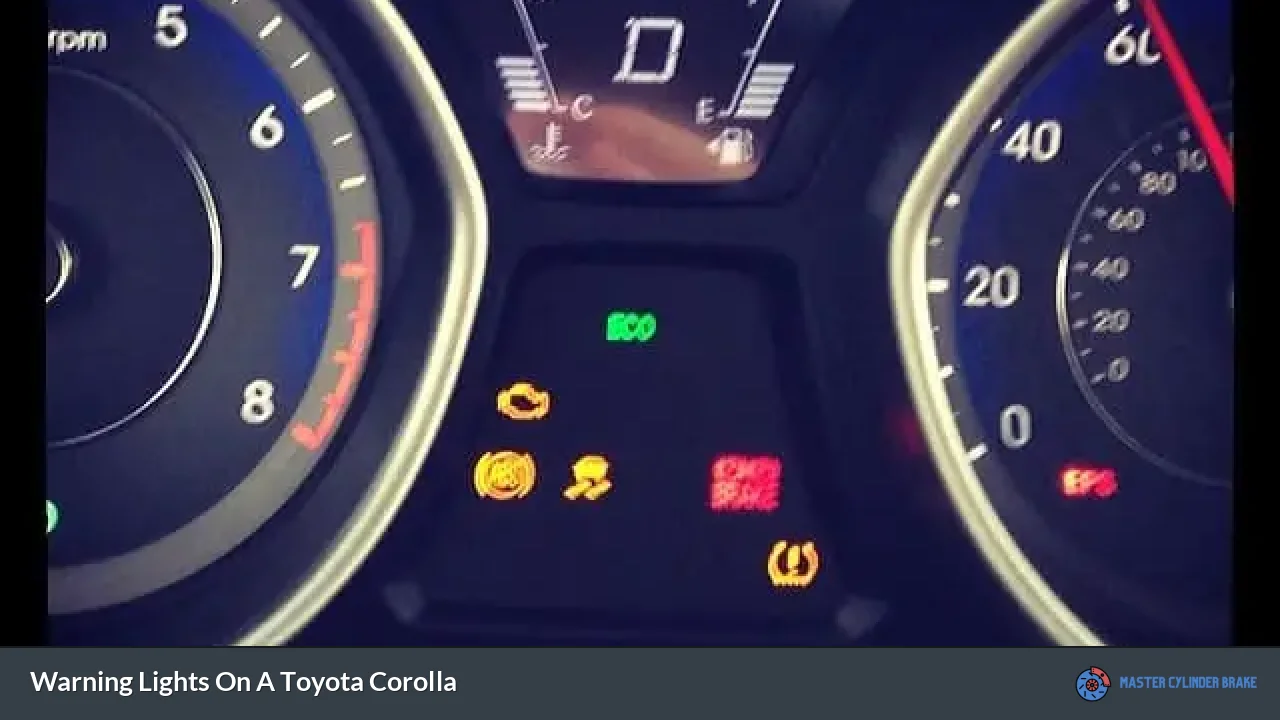Introduction:
Driving a Toyota Corolla is a joyous experience, but what happens when warning lights start illuminating your dashboard? These enigmatic symbols might seem perplexing at first, but they are designed to communicate vital information about your vehicle’s health and safety. In this article, we will decode some of the common warning lights found on a Toyota Corolla, helping you understand what they mean and how to respond.
The Check Engine Light:
One of the most dreaded warning lights is the infamous “Check Engine” light. When this light turns on, it can trigger anxiety in any driver. However, don’t panic just yet! The Check Engine light typically indicates a problem with the engine or its components. It could be as minor as a loose gas cap or a more serious issue requiring immediate attention. To diagnose the specific problem, it’s crucial to consult a professional mechanic who can utilize diagnostic tools to pinpoint the cause.
The Battery Light:
When your Toyota Corolla’s battery light flickers on, it’s a sign that there may be a problem with the charging system. This light often indicates an issue with the alternator or the battery itself. If this light persists, it’s important to have your electrical system checked promptly to prevent unexpected breakdowns.
The Oil Pressure Light:
The oil pressure light is a critical indicator that should never be ignored. When this light comes on, it means that the engine’s oil pressure has dropped below safe levels. Low oil pressure can lead to serious engine damage if not addressed immediately. Stop your vehicle as soon as it is safe to do so, check the oil level, and consult a professional technician for further inspection.
The Tire Pressure Monitoring System (TPMS) Light:
Maintaining proper tire pressure is essential for your vehicle’s performance and safety. The TPMS light alerts you when one or more tires have low pressure. Underinflated tires can affect fuel efficiency, handling, and tire wear. If the TPMS light illuminates, ensure that your tires are inflated to the recommended pressure levels as specified in the owner’s manual.
Conclusion:
Being aware of the warning lights on your Toyota Corolla is crucial for a safe and reliable driving experience. Remember, these lights serve as your car’s communication system, providing valuable insights into potential issues. Familiarize yourself with the meanings behind these warning lights, and don’t hesitate to seek professional assistance when needed. Stay informed, stay safe, and enjoy the ride!
Toyota Corolla Warning Lights: Decoding the Dashboard Signals for Optimal Safety
Introduction:
When it comes to driving safely, being aware of your vehicle’s warning lights is crucial. The Toyota Corolla, a popular and reliable car, comes equipped with an array of dashboard warning lights that can indicate potential issues. Understanding these signals will empower you to take appropriate action and ensure optimal safety on the road. Let’s dive into the world of Toyota Corolla warning lights and decode their meanings.
The Check Engine Light:
One of the most common warning lights you may encounter is the check engine light. This light, often depicted as an engine symbol, illuminates when there’s a fault in your vehicle’s engine or emissions system. It could be something as simple as a loose gas cap or a more serious issue that requires immediate attention from a qualified mechanic. Ignoring this light may lead to further damage and costly repairs down the line.
The Oil Pressure Light:
Keeping an eye on your engine’s oil pressure is vital for its smooth operation. When the oil pressure light turns on, it indicates a drop in oil pressure. Insufficient oil pressure can cause engine damage, leading to expensive repairs. If you see this light, pull over safely and check the oil level. If it’s low, add oil immediately. If the light persists, seek professional assistance.
The Battery Light:
The battery light, usually resembling a battery-shaped symbol, signifies an issue with your vehicle’s charging system. It could indicate a malfunctioning alternator, a worn-out battery, or loose connections. A failing charging system may result in a drained battery and eventual stalling of your vehicle. Promptly have your charging system inspected by an expert to avoid unexpected breakdowns.
The Tire Pressure Monitoring System (TPMS) Light:
Maintaining proper tire pressure ensures optimal handling and fuel efficiency. The TPMS light alerts you when one or more tires have low pressure. Underinflated tires can compromise safety and reduce fuel economy. When this light illuminates, check your tire pressures using a gauge and inflate them to the recommended levels. If the light persists, there may be a puncture or a malfunctioning sensor requiring attention.
Conclusion:
Understanding the meaning behind the warning lights on your Toyota Corolla’s dashboard is essential for your safety and vehicle maintenance. From the check engine light to the TPMS light, each symbol conveys valuable information about potential problems. By promptly addressing these warnings, you can prevent further damage, costly repairs, and ensure a smooth driving experience. Stay vigilant and take action whenever a warning light demands your attention, putting safety first on every journey.
Unveiling the Mystery: What Do Toyota Corolla Warning Lights Really Mean?

Picture this: you’re cruising along in your trusty Toyota Corolla, enjoying a smooth drive, when suddenly, a warning light blinks on your dashboard. Panic sets in as questions flood your mind. What could it mean? Is it something serious? Don’t fret! In this article, we will decode the enigma of Toyota Corolla warning lights, helping you understand what they truly signify.
Let’s start with the basics. Warning lights are your car’s way of communicating with you. They serve as an early warning system, alerting you to potential issues that require attention. Ignoring these lights can lead to more significant problems down the road, so it’s essential to decode their meanings promptly.
One common warning light is the check engine light. When this little marvel illuminates, it signifies that your vehicle’s onboard diagnostics system has detected a potential issue with the engine or its components. It could range from something as simple as a loose gas cap to a more complex problem within the engine itself. Either way, it’s best to have it checked by a qualified mechanic to avoid any further complications.
Another frequently encountered warning light is the battery light. This light indicates a problem with your vehicle’s charging system. It could be a faulty alternator, a loose connection, or a worn-out battery. Continuing to drive with this light on may result in a dead battery and an inconvenient roadside breakdown. So, consider getting it inspected and repaired as soon as possible.
Now, let’s shed some light on the tire pressure warning light. When this illuminates, it means that one or more of your tires have low pressure. Driving with insufficient tire pressure can compromise your safety and fuel efficiency. Make sure to check your tire pressures regularly and inflate them to the recommended levels.
Additionally, the oil pressure warning light deserves attention. If this light turns on, it indicates low oil pressure, which could result from insufficient lubrication in the engine. Operating your car with low oil pressure may cause severe damage to the engine, so it’s crucial to stop, check the oil level, and consult a mechanic if needed.
Stay Ahead of the Game: Understanding the Most Common Warning Lights on a Toyota Corolla
Are you ready to stay ahead of the game when it comes to understanding the most common warning lights on a Toyota Corolla? It’s crucial to be familiar with these indicators to ensure your safety and prevent potential issues while driving. In this article, we’ll delve into some of the key warning lights that you might encounter in your Corolla and what they signify.

One of the most recognizable warning lights is the check engine light. When this light illuminates, it’s a signal from your car’s onboard diagnostic system that something is amiss. It could indicate a range of problems, from a loose gas cap to more serious engine issues. If you see this light, it’s advisable to have your vehicle inspected by a qualified mechanic.

Another important warning light to pay attention to is the oil pressure light. This light typically looks like an oil can or a dripping oil symbol. When it lights up, it means that your engine’s oil pressure has dropped below the recommended level. Low oil pressure can lead to engine damage if not addressed promptly. Stop the car, check the oil level, and consult a professional if necessary.
The battery warning light deserves your attention as well. It resembles a battery-shaped icon and indicates an issue with the charging system. It could mean that your battery is not charging properly or that there’s a problem with the alternator. Ignoring this warning may leave you stranded with a dead battery.
If you spot the ABS warning light, it signifies an issue with your car’s anti-lock braking system. Your brakes should still function, but the anti-lock feature may be disabled. It’s crucial to have this system checked by a certified technician to maintain optimal safety.
These are just a few examples of the warning lights you may encounter in a Toyota Corolla. Remember, each light serves as a valuable early warning system for potential problems. Regularly checking your vehicle and addressing any illuminated warning lights promptly will help keep you safe and your Corolla running smoothly.
Safety First: How Toyota Corolla’s Warning Lights Help Prevent Potential Issues
When it comes to driving, safety should always be the top priority. That’s why the Toyota Corolla is equipped with advanced warning lights that play a crucial role in preventing potential issues on the road. These warning lights serve as your car’s vigilant eyes, continuously monitoring various systems and components to keep you informed and protected.
One of the key warning lights in the Toyota Corolla is the Check Engine Light. This light acts as a guardian, alerting you to any potential problems with the engine or its related components. Whether it’s a loose gas cap or a more serious issue, this warning light ensures that you take appropriate action to avoid further damage or breakdowns.
Another important warning light is the Tire Pressure Monitoring System (TPMS) light. It keeps a close watch on the air pressure in your tires, signaling if there’s a significant drop in pressure. Maintaining proper tire pressure not only improves fuel efficiency but also enhances traction and handling, reducing the risk of accidents caused by underinflated or overinflated tires.
The Battery Warning Light is yet another essential feature in the Toyota Corolla. This light provides early detection of battery-related problems, such as a weak battery or a faulty charging system. By staying attentive to this warning, you can avoid being stranded with a dead battery and ensure a reliable start every time you turn the key.
Additionally, the Brake System Warning Light plays a vital role in keeping you safe on the road. It alerts you to any abnormalities in the braking system, such as low brake fluid levels or a malfunctioning ABS (Anti-lock Braking System). Prompt attention to this warning ensures that your brakes are functioning optimally, allowing for quick and secure stops when needed.
The Toyota Corolla’s warning lights act as diligent guardians, constantly monitoring the car’s vital systems to ensure your safety. From the Check Engine Light to the TPMS, Battery Warning Light, and Brake System Warning Light, these indicators empower you to take preventive measures and address potential issues before they escalate. With safety as its foremost concern, the Toyota Corolla provides peace of mind on every journey.
